
I met Jeff Pulver in 2010 here in Detroit. He’s an amazing guy, one of the originators of Vodaphone and a “serial investor” in hundreds of techie start-ups here in the States, in Israel, and around the world.
My connection with him started with the “140 Characters Conferences” – events held around the U.S. in TED Talks fashion, bringing together the diversity of people to tell their stories about social media and community connections. Jeff invited me to speak about the origins and popularity of the Classic Rock format, a subject obviously near and dear to my heart.
Detroit was damaged goods in 2010. The auto industry was upside down, and GM and Chrysler were in the throes of bankruptcy. The recession that hit the nation at that time devastated Detroit. It was close to being nuclear winter here.
So, the fact that Pulver brought his cool conference to the Motor City – at a downtown venue, the Fillmore, no less – made this special. Detroit’s mayor, Dave Bing, showed up to greet the crowd. It was a big deal for a city struggling for survival.
At the time, I was just dabbling with Twitter, so to better prep for this conference, I dove in, developed a better understanding of the platform, and started to get seriously engaged. That was more than eight years ago, and I haven’t stopped connecting with the famous, the infamous, and thousands of fascinating people who use the site.
Back in those days, Twitter was misunderstood, thought to be a place where users shared their dietary and personal activities. At that time, Ashton Kutcher and CNN were battling it out to see who could generate the most “followers.” It was a dumb stunt, and did little to make Twitter a more vital social platform.
Today, Twitter is thought of as Donald Trump’s social soapbox. And for good reason. For better or worse, he’s its most famous user – in spite of the fact his closest advisers would rather he shut down his account or at least give up his iPhone.
Pulver and I forged a relationship, and a few years later, he was a featured speaker at our Jacobs Media Summit, a conference with which we partnered with Arbitron for a number of years.
Jeff has moved on. You can still connect with him on Twitter, but he’s focused on other ventures. And the other day, I ran across him in a Forbes story by John Koetsier.
The story reminded me of Steve Jones’ “Brand Like A Rock Star” speeches and books – the idea that companies can learn a lot of about marketing and branding from rock bands. Steve is an executive at Stingray (formerly Newcap) in Canada by day, and spends the rest of his time on the speaker circuit.
In the story, Pulver makes the same analogies with start-ups, likening them to great rock bands. He points out the glaring similarities and he lists five attributes that both have – a big part of the process he uses to evaluate new businesses and startups.

Of course, I’ve added a few elements to Jeff’s list. His premise is a good one, and one that radio people will instantly connect with.
With any great rock band, gut and instinct play a role, in much the same way great A&R guys (and gals), as well as successful programmers pride themselves on having “great ears.” That means seeing a band or performer in a live venue and knowing there’s something there. Or hearing a song for the first time, and having that “Eureka!” moment that it’s a hit.
Pulver explains his startup evaluation process with would-be, starry-eyed young CEOs lasts only 20 minutes. He says he typically knows within three minutes if there’s a “there there” – that is, whether he should invest in them. And “Then they have 17 minutes to convince me not to.”
I have a similar instinct for radio operations by walking through the halls, and then simply sitting down with a PD for a quick conversation about the station, the staff, the strategy, the positioning, and the results. You can usually tell whether you’re dealing with a quality operation, a radio brand that is in it for the long haul, and a programmer who “gets it.”
And like killer rock bands, here are the questions Jeff asks to make his judgement calls:
1.Who is the lead singer? That is, who is the front man – or woman? When you think about some of the great radio stations – from the present or the past – it’s often a PD or GM filling that role. Out-sized personalities like Jimmy deCastro, John Sebastian, Scott Shannon, Oedipus, and many others were the faces of their brands.
As it is with rock bands. It’s Mick Jagger, Steven Tyler, Robert Plant, Freddie Mercury, Kurt Cobain, and Jim Morrison who weren’t just the lead singers but the faces of their enterprises. Great radio stations have this “front-facing” person on staff – the one you instantly think of when you think of the call letters. This isn’t just about having a great voice – it’s about leadership.
2. Who is the drummer? This is the person at the radio station that keeps the organization going – the backbeat of the place. As Pulver points  out, the drummer “keeps people honest” and gets the job done.
out, the drummer “keeps people honest” and gets the job done.
Like Charlie Watts, Keith Moon, Don Henley, or Neil Peart, these people provide the rhythm of a station, the players who are the steady, constant pulse of the enterprise.
3. Are you a cover band? This refers to whether the content is original – or whether a station is just another knock-off of something else. As Pulver points out, either can be successful, but it’s important to know just how unique your content and brand truly are.
Are you doing benchmarks that can be heard on 100 other morning shows or something special they could only get in Pittsburgh, Poughkeepsie, or Portland?
Knowing whether the product – whether it’s a business or a radio station – is unique is a key element in brand building. In radio and in music, you most definitely want to avoid being a one-hit – or a one-book – wonder.
4. What’s your genre? Pulver believes that not every business understands the space they’re in. In radio, most stations know the position they occupy – that is, when they’re the primary Country, Rock, or AC station. It’s when you get to that next layer – stations trying to fit their way into a position already occupied where the ambiguity creeps in.
Radio programming is like a game of musical chairs. You’ve got to figure out where you belong in the big scheme of things. Pulver notes that when the genre is fuzzy, it can lead to problems with marketing and promotion – that is, trying to explain the station to the audience, to its advertisers, and sometimes to its staff.
 5. Who sings your songs? In other words, who tells your story, who “amplifies” the message, and who connects with a station’s various constituencies? Great bands need this person to convey its messages, just as radio stations need that “connector” – often a marketing director, but not necessarily so. This is where great storytelling and public relations come into play.
5. Who sings your songs? In other words, who tells your story, who “amplifies” the message, and who connects with a station’s various constituencies? Great bands need this person to convey its messages, just as radio stations need that “connector” – often a marketing director, but not necessarily so. This is where great storytelling and public relations come into play.
I’ve been fortunate to work with a handful of some of the best “singers” in the business – marketing directors like Heidi Raphael, Lisa Namerow, Mark Randall, Julie Finkel, Brad Wallace, Natalie DiPietro, and a handful of others who knew how to deliver and disseminate the message. At a time when so many complain that radio needs to do a better job telling its story, a strong player in this role can take a station’s assets and truly spread the word.
And then there are my additions to Jeff’s analogy:
6. Who’s your manager? Radio stations, like rock bands, are places where creativity is valued and really great talent is known for “coloring outside the lines.” It requires a controller of the chaos – people like Brian Epstein, Colonel Tom Parker, and Irving Azoff – who can bring logic and a business sense to an organization that is often a little too “right brain” for its own good.
Rock bands are famous for their squabbles, disputes, rivalries, and sometimes their breakups. So are great morning and personality shows. It’s a smart, savvy, sensible manager who knows how to get in front of the craziness to keep the organization from shooting itself in the head.
7. Are you a great live band? Being able to perform in public and move audiences are what separates good bands from legends. That’s why decades later, fans are paying insane amounts of money to see the Stones or Springsteen on stage. Great performers who are remarkable on the road are worth their weight in gold.
Great radio stations can take the show on the road – performing in front of fans, advertisers, and community leaders. A solid talent in a sound-proofed, safe studio is one thing – being able to do it live in front of the people who matter is a special gift. And never forget we are in the entertainment business.
 8. How’s your merch? Go to any live show, and you’ll instantly see where the profits are being generated – those long lines where fans just have to have a shirt, a hat, a poster, and every other piece of branded merchandise on sale for unreasonable prices.
8. How’s your merch? Go to any live show, and you’ll instantly see where the profits are being generated – those long lines where fans just have to have a shirt, a hat, a poster, and every other piece of branded merchandise on sale for unreasonable prices.
The margins on this stuff are crazy, and that’s the point. Bands – or stations – that have created amazing brands fans will pay to display are what make them sustainable. If you wonder why all these Classic Rock bands that have been around for decades continue to be popular, in many cases they have worked hard on their logoware and branding elements.
9. What’s your digital strategy? It’s one thing to sell music and put butts in seats – it’s another to be able to levitate legions of fans. And it starts  with social and web connections. The great performers out there – whether they’re playing Hip-Hop, Rock, or Country, or they’re Jimmy Buffett or Taylor Swift, have figured out how to engage with fans – in person, on websites, in databases, via apps, with podcasts, and of course, in the social space. Whether it’s on Twitter, selling out VIP Sections at concerts, or with fan clubs, great bands appreciate this tech-driven, fan connection.
with social and web connections. The great performers out there – whether they’re playing Hip-Hop, Rock, or Country, or they’re Jimmy Buffett or Taylor Swift, have figured out how to engage with fans – in person, on websites, in databases, via apps, with podcasts, and of course, in the social space. Whether it’s on Twitter, selling out VIP Sections at concerts, or with fan clubs, great bands appreciate this tech-driven, fan connection.
It’s amazing how many great radio stations miss this piece, lagging behind their own listeners and advertisers when it comes to technology. Those who have invested in human and financial resources. And they’ve done their homework – they know how to connect with the audience because they’ve learned the key “touch points” and have built their own social networks.
10. Do you have any groupies? Don’t laugh. It’s great to have support from that core group of fans who will be with you wherever you go and whatever you do. Sometimes, radio mistakenly refers to them as “contest pigs.” But that denigrates and devalues their importance.
They are Uber P1s, or “brand advocates” – bands of fanatics who show up to remotes, events, parties, and grand openings – whether they’re any good or not. They love the station with a capital “L” and can play a key role in a station’s popularity and ability to weather the storms. You only wish more people had their passion and dedication.
Jeff Pulver gets it – he always has. He has that special instinct to recognize greatness – whether it’s playing instruments on stage, building a business – or running a great radio station.
So, what band is most like your radio station?
- What To Do If Your Radio Station Goes Through A Midlife Crisis - April 25, 2025
- A 2020 Lesson?It Could All Be Gone In A Flash - April 24, 2025
- How AI Can Give Radio Personalities More…PERSONALITY - April 23, 2025




Funny mentioning Jimmy Buffett and Taylor Swift. Their devotion and connection to their fans is extraordinary compared to almost anybody else. Both understand that there’s no such thing as “the public.”
Both could obviously care less about anybody but their fans. Buffett actually kept his success quiet for years before Garth Brooks bumbled into his massive fanbase that “the industry” had no idea even existed.
People like these give me hope and they are certainly the ideal model for a locally-focused radio station.
And that’s why I mentioned them both, Bob. They “get” the value of fans & interacting with them. Thanks for the comment.